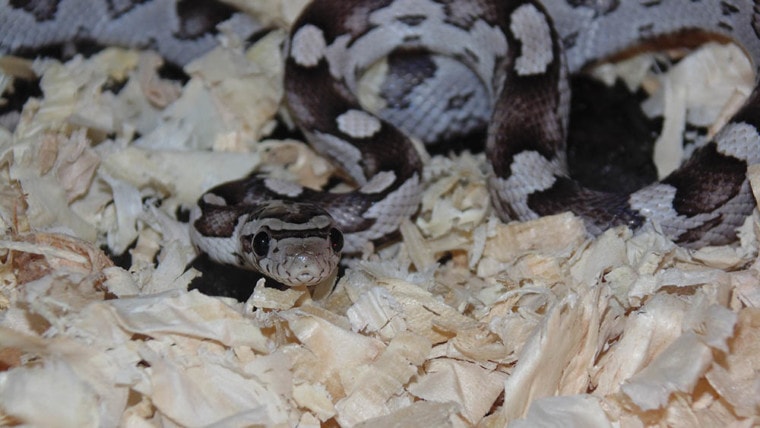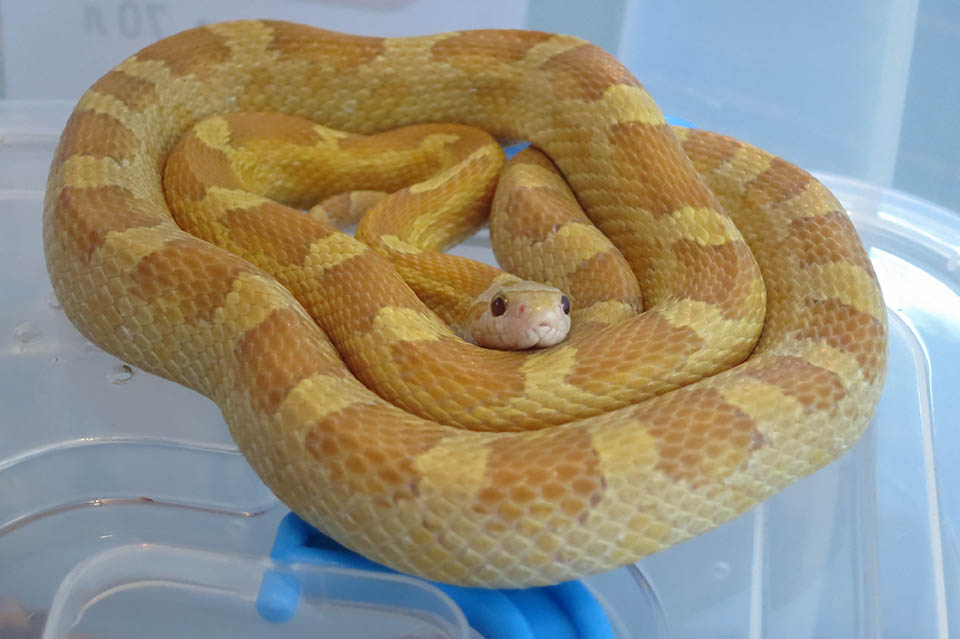
Corn snakes are a preference among snake enthusiasts, and they often are top selections for first-time owners. These snakes tend to stay relatively small and don’t mind being handled frequently, so they are a terrific introduction to reptile owning.
Anery is an abbreviation for anerythristic, meaning they lack red pigment. So, unlike traditional, brightly colored corn snakes, the anery corn snake is usually duller with tones of gray and neutrals.
Quick Facts about Anery Corn Snake
| Species Name: | Pantherophis guttatus |
| Common Name: | Anery Corn Snake |
| Care Level: | Beginner |
| Lifespan: | 6-8 years |
| Adult Size: | 2-6 feet |
| Diet: | Carnivore |
| Minimum Tank Size: | 20 gallons |
| Temperature: | 75-92 degrees Fahrenheit |
| Humidity: | 40%-50% |
Do Anery Corn Snakes Make Good Pets?
Anery corn snakes are highly recommended for novice owners and seasoned enthusiasts alike. As a species, corn snakes tend to be very gentle and receptive to handling.
Anery corn snakes also have hardy appetites with no trouble gobbling up their meal. They eat on a regular schedule without fail. Be careful not to overfeed them, as they will happily consume past the point of being satiated.
Since they are so resilient, they aren’t specifically prone to illness. That doesn’t mean you should fall short on any aspect of care—it just means they aren’t fragile compared to other snakes.
Corn snakes are also very easy to find. They are one of the most popular snakes on the market, so finding a breeder with aneries shouldn’t be too hard.
If you have children 6 or older, they make a terrific startup pet to create a reptile lover for life. So, as you can see, there aren’t many things that could make the anery corn snake anything but a fantastic pet.

Appearance
Anery is a word that means lacking erythrism, which is the red pigment in the snake’s scales. So, in this breed, you often see their clear lack of red hue, unlike their other corn snake cousins.
When you see an anerythristic snake, they usually take on neutral tones like cream, charcoal, gray, black, and beige. Several morphs fall under the anertythrisitc category, each touting their own unique attributes.
While this is not an exhaustive list, here are some different anerythrisitic corn snake morphs:
How to Take Care of Anery Corn Snakes
The environment for your corn snake is the single most crucial aspect of care besides diet. Your anery will need proper temperature, humidity, and substrate to thrive in captivity comfortably.
Without covering all of these bases, you could wind up dealing with unnecessary health issues or a shortened lifespan. So, let’s learn how to perfect the setup to make sure your anery prospers.
Habitat, Tank Conditions & Setup
Tank
Anery corn snakes are long and slender, growing up to 5 whole feet as adults! But luckily, they don’t need much extra space. A full-grown anery corn snake should have at least a 20-gallon tank, which is a modest size.
If you feel like your snake is a bit more active than others, they will gladly live in a bigger enclosure. Corn snakes love climbing, so you can offer lots of limbs, branches, and perches that they can wind around.

Lighting
Technically, corn snakes don’t need additional light in their enclosure. However, sometimes low UVB light can be beneficial for your snake. It helps their bodies get an extra dose of vitamin D and calcium to strengthen bones and improve scale quality.
Heating (Temperature & Humidity)
Since snakes cannot regulate body temperature, your anery corn snake needs to have a warm and cool side of the tank. They can alternate back and forth between the sides depending on what their systems need to balance their body heat.
The cool side of the tank should stay between 75 and 82 degrees F. On the warmer side, it should stay roughly 85 degrees F with a basking spot of 92 degrees F. They require basking lamps and heating pads that you alternate between during day and night hours.
Your anery needs moisture to keep its scales supple and shiny. Humidity is a very crucial factor for overall skin care and smooth shed transition. Once you have a hydrometer monitor, the humidity levels should stay between 40% and 50%.
Substrate
Since your snake needs a proper amount of moisture, offering a suitable substrate that fits its needs is paramount. Also, corn snakes are burrowing champions that love to submerge themselves into the material.
Aspen substrate is ideal for corn snakes because it has excellent moisture retention and burrowing potential. Your substrate should be a few inches high, especially as adults.

Tank Recommendations
| Tank Type: | 20-gallon glass enclosure |
| Lighting: | Low UVB light (optional) |
| Heating: | Heating pad/tape on bottom of enclosure |
| Best Substrate: | Aspen bedding |
Feeding Your Anery Corn Snake
Corn snakes are carnivorous that eat small rodents and amphibians in the wild. However, in captivity, rodents will suffice. You can feed your anery pinky, fuzzy, or small mice depending on their life stage.
Juvenile corn snakes eat every 7-10 days. Adults two years and older eat once every 21 days.
- Related Read: Can Pet Snakes Eat Eggs? What You Need to Know!
Diet Summary
| Insects: | 0% of diet |
| Meat: | 100% of diet – small/medium-sized rodents |
| Supplements Required: | N/A |
Keeping Your Anery Corn Snake Healthy
Before you bring your anery corn snake home, it’s best to find an exotic vet in your area. You will need professionals to step in if anything happens with your snake. Plus, they benefit from annual checkups just to make sure nothing goes undetected.
Since reptile keeping poses such unique environmental perfection, a lacking can lead to health problems you can otherwise avoid.
Common Health Issues
Here are a few health problems your snake might face in their lifetime:
Lifespan
If you keep your corn snake healthy and their environment is appropriate, they can live up to 8 years in captivity.

Breeding
If you’re interested in breeding, get a detailed tutorial explaining that explains the process thoroughly. Of course, if you plan to breed your anery, they need to be a certain age—so if you buy a juvenile, you could be waiting a while.
Female corn snakes are usually slower to mature, not reaching sexual maturity until roughly 30 months. Males, on the other hand, reach sexual maturity by 18 months.
When the conditions are right for breeding, the male will align cloacal openings with the female. Breeding will commence—and soon, you will start to notice your gravid female has a hefty appetite about 5 weeks after mating.
Once she reaches her prenatal shed point, it’s time to place her in a nesting container. She needs a sheltered place to lay her clutch, so she will choose the spot she feels the safest.
Corn snakes lay eggs between 30 and 45 days, up to 30 eggs. The clutch will hatch in about 8 weeks.
Are Anery Corn Snakes Friendly? Our Handling Advice
Anery corn snakes are very tolerant reptiles. They don’t mind being handled, as they aren’t very jumpy or skittish. These snakes love exploring, so be careful that they don’t get away from you.
Always remember to wash your hands after handling your reptile, as they can harbor diseases like salmonella that can make you very sick.
Shedding & Brumation: What to Expect
Corn snakes typically shed two to six times a year. Total times will depend on the life stage of your snake. Corn snakes might actually face a few issues with shedding, so making sure their humidity levels are accurate is very critical.
Some snakes will enter a brumation period between September and December. Everything will slow down—metabolism, activity, and appetite.

How Much Do Anery Corn Snakes Cost?
If you buy an anery snake from a breeder, you can expect to pay somewhere between $50 and $150.
Actual price can change because all breeders charge different rates based on quality and age. Juveniles tend to be a little cheaper than adults.
You might even get lucky and find an anery corn snake with or without supplies for cheap or even free. Some owners find themselves on hard times and simply want a better home for their pet.
If you do get lucky, it’s important to factor in other costs, too. Here are a few things you might need to buy:
Care Guide Summary
Final Thoughts
The gorgeous anery corn snake is so low maintenance and rewarding. If you think you want to take the plunge, make sure you can gather up any necessary supplies and locate an exotic vet before purchasing.
You have a few different options when buying, so make sure to explore all of your avenues. Happy hunting!
Also see:
- Best Pet Reptiles for Beginners: Pictures & Care Tips
- How to Take Care of a Garter Snake (Care Sheet & Guide)
Featured Image Credit: PauloPadrao, Shutterstock












